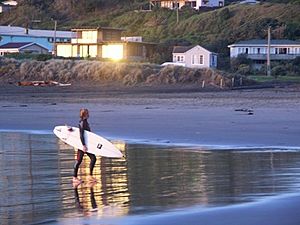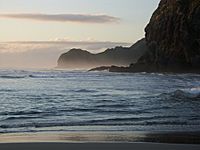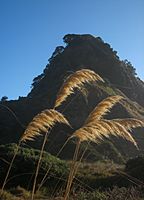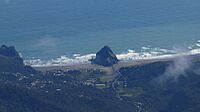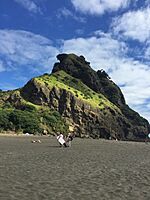Piha facts for kids
Quick facts for kids
Piha
|
|
|---|---|
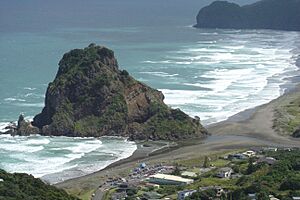
Piha and Lion Rock from the access road above
|
|
| Country | New Zealand |
| Region | Auckland |
| Ward | Waitākere ward |
| Local board | Waitākere Ranges Local Board |
| Electorates |
|
| Area | |
| • Total | 5.24 km2 (2.02 sq mi) |
| Population
(June 2023)
|
|
| • Total | 1,070 |
| • Density | 204.2/km2 (528.9/sq mi) |
Piha is a coastal settlement in West Auckland, on the western coast of the Auckland Region in New Zealand. It is one of the most popular beaches in the area and a major day-trip destination for Aucklanders throughout the year, and especially in summer.
Piha is 39 kilometres west of Auckland city centre, on the Tasman Sea coast to the north of the Manukau Harbour, on the western edge of the Waitākere Ranges. Immediately to the north of Piha is Whites Beach, and immediately to the south is Te Unuhanga-a-Rangitoto / Mercer Bay; land access to both is only by foot. The nearest beaches accessible by road are Karekare to the south, and Anawhata to the north.
Contents
History
The area is traditionally a part of rohe of the Tāmaki Māori tribe Te Kawerau ā Maki. The area is named for Te Piha, the traditional name of Lion Rock which was later applied to the wider area, and refers to the pattern made when waves hit against the rock. The area was the location of many pā and villages, including a headland at Te Waha Point north of the beach, where many karaka trees associated with the former pā grow, and Lion Rock, which was the location of Whakaari pā. Archaeological surveys have shown the remains of platforms, midden and terraces on Lion Rock, as well as fragments of traditional textiles, dating back to a time before European contact. The earthworks of Whakaari pā are not well preserved due to erosion.
Te Unuhanga-a-Rangitoto / Mercer Bay to the south was traditionally known by the name Te Unuhanga o Rangitoto, referencing the traditional story of Te Kawerau ā Maki of early ancestor Tiriwa, who formed the bay by moving Rangitoto Island from the West coast to the Hauraki Gulf / Tīkapa Moana. The English language name references Andrew Mercer, an Auckland settler who received Crown grant in June 1866.
At the turn of the 20th century, holidaymakers would travel by coach from Glen Eden to stay at guest houses in Piha. In February 1939, two Australian visitors to Auckland, G R Mackey and J A Talbot, committed arson at a Piha bach. The fire was lit as a part of an insurance scam, and a body of a recently buried soldier was taken from Waikumete Cemetery and placed inside the bach.
Demographics
Piha covers 5.24 km2 (2.02 sq mi) and had an estimated population of 1,070 as of June 2023, with a population density of 204 people per km2.
| Historical population | ||
|---|---|---|
| Year | Pop. | ±% p.a. |
| 2006 | 822 | — |
| 2013 | 858 | +0.61% |
| 2018 | 984 | +2.78% |
Piha had a population of 984 at the 2018 New Zealand census, an increase of 126 people (14.7%) since the 2013 census, and an increase of 162 people (19.7%) since the 2006 census. There were 396 households, comprising 498 males and 486 females, giving a sex ratio of 1.02 males per female. The median age was 43.4 years (compared with 37.4 years nationally), with 189 people (19.2%) aged under 15 years, 108 (11.0%) aged 15 to 29, 561 (57.0%) aged 30 to 64, and 129 (13.1%) aged 65 or older.
Ethnicities were 94.8% European/Pākehā, 13.4% Māori, 3.4% Pacific peoples, 3.0% Asian, and 2.1% other ethnicities. People may identify with more than one ethnicity.
The percentage of people born overseas was 19.2, compared with 27.1% nationally.
Although some people chose not to answer the census's question about religious affiliation, 66.8% had no religion, 18.9% were Christian, 0.3% had Māori religious beliefs, 0.3% were Hindu, 0.6% were Buddhist and 4.6% had other religions.
Of those at least 15 years old, 279 (35.1%) people had a bachelor's or higher degree, and 48 (6.0%) people had no formal qualifications. The median income was $42,700, compared with $31,800 nationally. 198 people (24.9%) earned over $70,000 compared to 17.2% nationally. The employment status of those at least 15 was that 429 (54.0%) people were employed full-time, 129 (16.2%) were part-time, and 21 (2.6%) were unemployed.
Features and geology
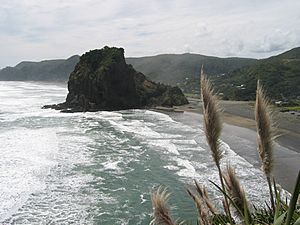
As well as two surf beaches there are also a sheltered lagoon and several streams in the area. The coastline and forested Waitākere Ranges offer a number of walks, or tramps, ranging from easy to very difficult. Due to the spread of the incurable kauri dieback disease large parts of the Waitākere Ranges were closed from 2018 until further notice.
Piha is a well known black sand beach, due to the high iron content, which originated from Mount Taranaki and earlier volcanoes in the area.
Lion Rock is a natural formation dividing North and South Piha beaches. It is an eroded 16-million-year-old volcanic neck, named for its similarity to a lying male lion when viewed from the rear (shore side), Lion Rock is immediately visible to visitors as they descend along the only access road. Lion Rock has become iconic not only of Piha, but of Auckland's West Coast in general. Lion Rock was featured on stamps as well as an Auckland phone book, and in December 1919 a memorial to local sawmillers who served in World War One was unveiled on Lion Rock.
About 2 km inland, on the Glen Esk stream, are the Kitekite Falls which while not very large are picturesque. Swimming is possible all seasons (though only for the cold hardened outside of summer) in a pool just above the falls. At the bottom of the falls is a sheltered picnic area popular with families in the summer time. There is another pool between the top falls and the bottom falls, but is closed due to Kauri dieback.
About 2 km inland, on the Piha Stream, is a small canyon.
About 1 km south of the South Beach is 'The Gap', which at low tide provides another lagoon and a blowhole.
Surfing
Piha was the birthplace of New Zealand board riding in 1958, and has been the scene of both New Zealand national and international surfing championship competitions.
Surf lifesaving
Two surf lifesaving clubs provide surf patrols in summer. Piha Surf Life Saving Club, the home of the TV series Piha Rescue, patrols the section of the beach to the south of Lion Rock. United North Piha Lifeguard Service is responsible for the section of the beach north of Lion Rock. Both clubs provide patrolled areas designated by red and yellow flags as is the custom with Surf Lifesaving in New Zealand and many other countries.
Safety information
The rip currents along this section of coast are very unpredictable and can shift with little warning. They claim many lives despite the efforts of surf life-savers. Most of these drownings, however, occur after lifeguards are off duty or after rock fisherman wearing heavy clothing are washed off rocks, out of sight of the lifeguards. Lifeguards advise swimming between the red and yellow flags, during patrol hours.
After the death of two men at Piha in February 2013, lifeguards say the water fools swimmers by appearing deceptively calm, obscuring strong rips, and people should stay out of the water if they are not confident swimmers.
Since 1992, six people have disappeared from or in the area of Piha with no trace, with one of the more publicised cases being Iraena Asher and the most recent being French teenager Eloi Rolland. No trace has been left by any of these people, and none of them have been found.
Piha Rescue
Piha Beach was the setting for a popular New Zealand reality television show. Aptly named Piha Rescue, it ran for 12 series over 14 years on TV1 and it featured the lives of the surf life savers at Piha Beach and educated the public on the beach safety, rip currents and swimming between the flags.
Photo gallery




